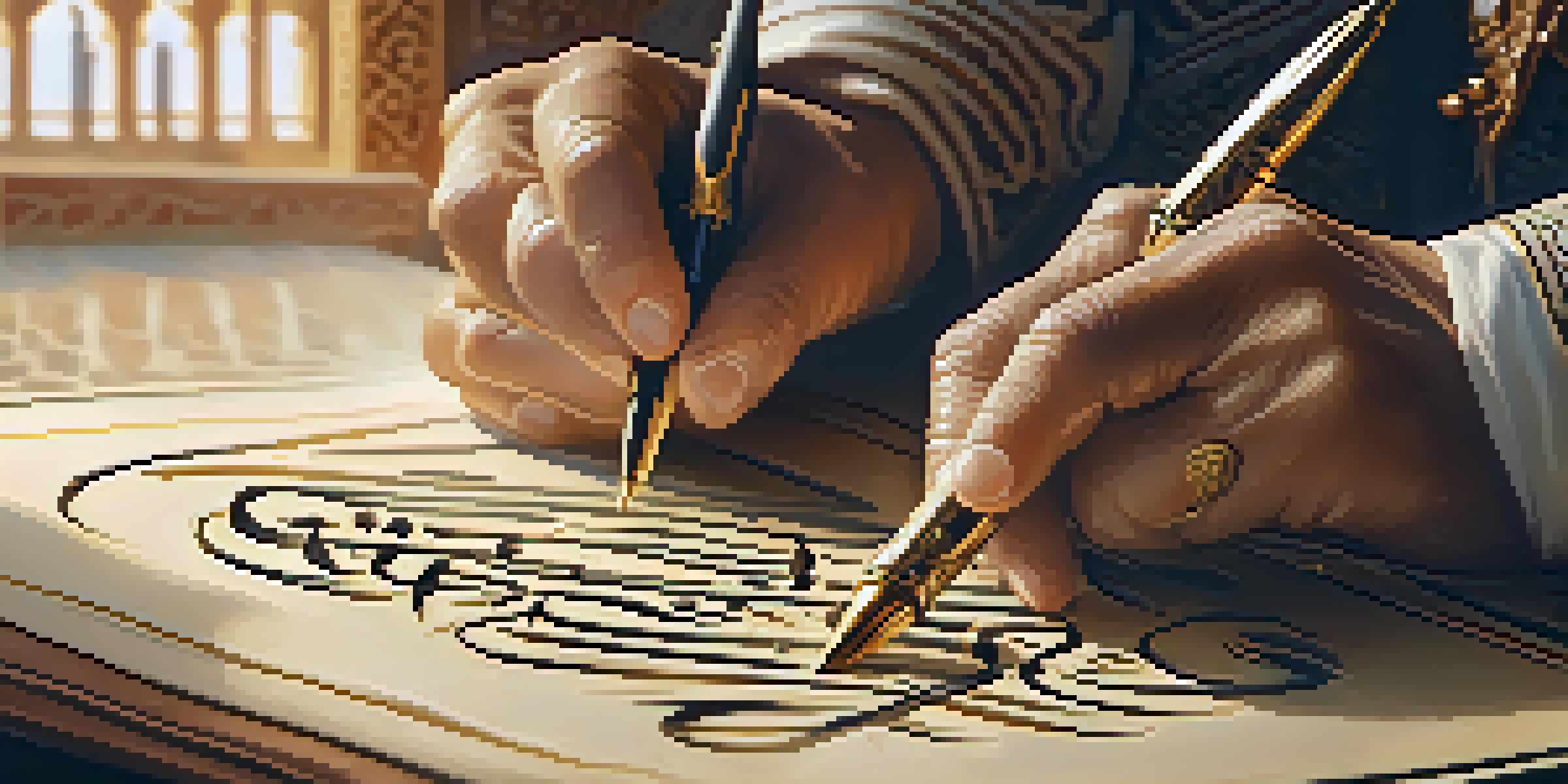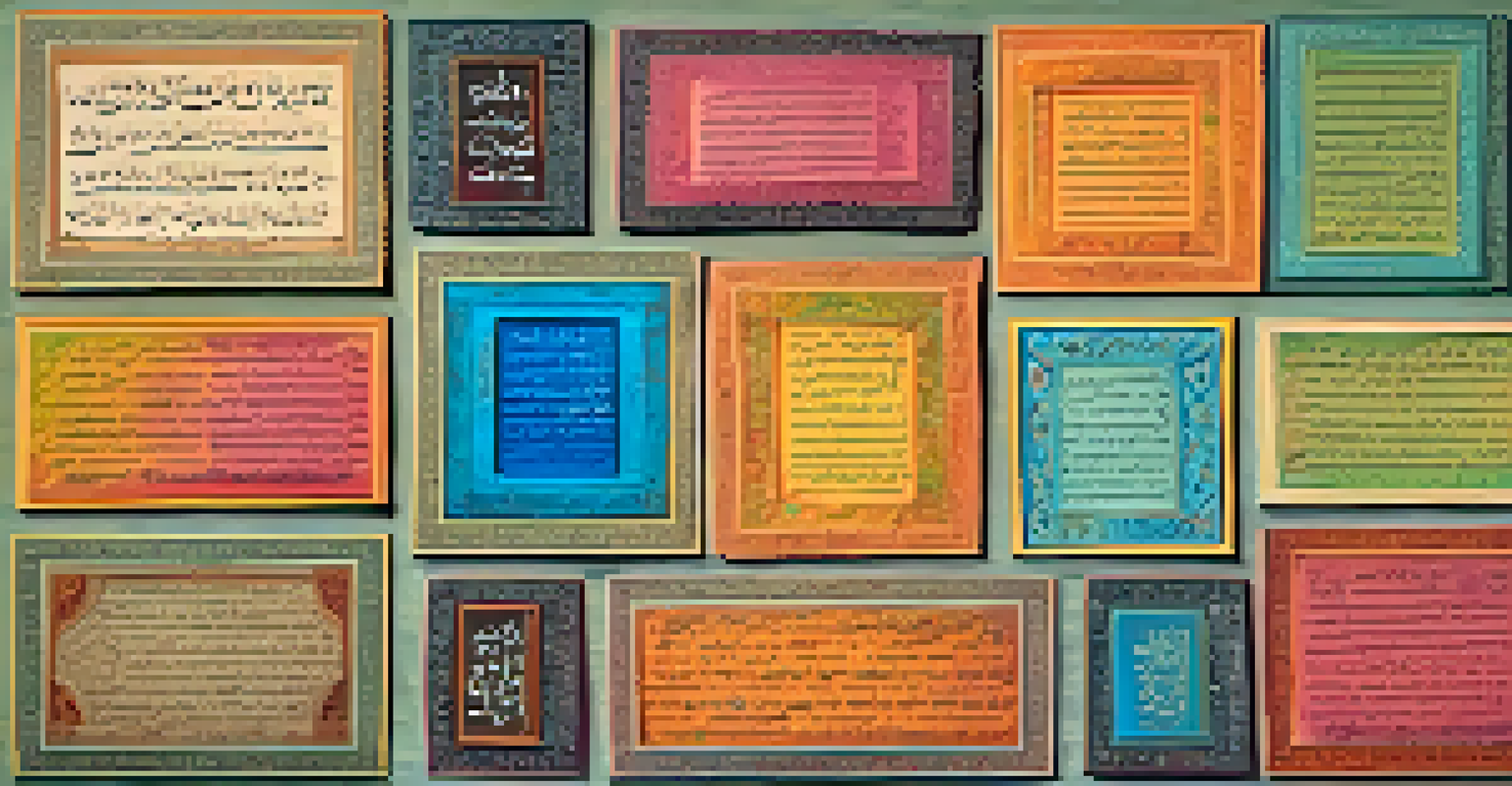Calligraphy in Different Cultures: A Global Perspective

The Art of Calligraphy: A Universal Language
Calligraphy is often described as a visual art form that combines creativity with technical skill. It's not just about writing; it's about expressing emotion and culture through the flow of letters. Across the globe, different cultures have adapted this art, giving it distinct styles and meanings.
Calligraphy is a way of life. It is a meditation, a way of expressing the inner self through the beauty of letters.
From the elegant strokes of Arabic script to the intricate designs of East Asian characters, calligraphy serves as a bridge connecting people through beauty and tradition. Each style tells a story, reflecting the history and values of its culture. This universal language allows for a shared appreciation of art, regardless of the spoken word.
As we explore calligraphy in various cultures, we uncover not just artistic techniques, but also the philosophies that shape each style. This exploration invites us to appreciate the diversity and richness that calligraphy brings to our world.
Arabic Calligraphy: A Spiritual and Artistic Journey
Arabic calligraphy is often regarded as one of the highest forms of art in the Islamic world. It serves both decorative and spiritual purposes, often used to adorn mosques and religious texts. The fluidity and grace of Arabic letters create stunning visual compositions that captivate the viewer.

The different styles, such as Diwani and Thuluth, each carry unique characteristics and historical significance. For instance, Diwani is known for its intricate curves and was historically used in royal decrees. This variety showcases the versatility and depth of Arabic calligraphy as both an art form and a means of communication.
Calligraphy as Cultural Expression
Calligraphy serves as a bridge connecting diverse cultures, expressing emotions and traditions through the beauty of written art.
Moreover, Arabic calligraphy is not just an art but a meditative practice for many artists. It allows individuals to connect with their spirituality while honing their skills, making it a deeply personal and communal experience.
Chinese Calligraphy: A Dance of Brush and Ink
Chinese calligraphy, or 'shufa,' is revered as one of the highest art forms, emphasizing the beauty of brushwork and the character of the artist. Each stroke is intentional and carries meaning, making it a blend of art and philosophy. The practice is often seen as a reflection of one's inner self and emotional state.
Writing is a form of art, and calligraphy is the highest form of that art, a spiritual journey that transcends mere words.
There are various styles in Chinese calligraphy, including Seal Script and Regular Script, each offering unique aesthetics and challenges. Mastering these styles can take years, as artists spend countless hours perfecting their technique. This dedication is what makes Chinese calligraphy not just an art, but a lifelong journey.
In Chinese culture, calligraphy is often linked to poetry and literature, intertwining the visual and verbal arts. This relationship enhances the appreciation of both forms, as calligraphy brings words to life through its expressive strokes.
Japanese Calligraphy: A Blend of Tradition and Modernity
Japanese calligraphy, known as 'shodō,' is deeply rooted in the practice of Zen Buddhism, emphasizing simplicity and mindfulness. The act of writing becomes a meditative experience, where every stroke is a moment of presence. This connection between art and spirituality is what makes shodō a unique practice among calligraphic traditions.
Japanese calligraphy incorporates various styles, such as Kaisho and Gyōsho, each offering its own flair and intricacies. Artists often blend these styles, creating a personal expression that resonates with contemporary themes while honoring traditional techniques. This adaptability is a testament to the evolving nature of Japanese calligraphy.
The Evolution of Calligraphy Styles
Different cultures have developed unique calligraphic styles, each reflecting historical significance and artistic philosophies.
In recent years, shodō has gained global popularity, inspiring artists worldwide to experiment with its techniques. This fusion of traditional Japanese calligraphy with modern influences showcases the art's versatility and enduring appeal.
Indian Calligraphy: A Tapestry of Scripts and Cultures
Indian calligraphy is a vibrant tapestry woven from various scripts and languages, including Devanagari and Urdu. Each script offers its own artistic style, rich history, and cultural significance. The beauty of Indian calligraphy lies in its diversity, reflecting the subcontinent's multitude of languages and traditions.
One of the most notable forms is 'Nasta'liq,' often used in Urdu poetry, which is characterized by its flowing lines and elegant curves. This style not only enhances the beauty of the written word but also encapsulates the emotions behind the poetry. Such intricate artistry invites viewers to engage with the text on a deeper level.
Furthermore, Indian calligraphy has evolved, incorporating modern techniques and influences while retaining its traditional roots. This blending of old and new continues to inspire artists and showcases the dynamic nature of calligraphy in India.
Western Calligraphy: From Manuscripts to Modern Art
Western calligraphy has its origins in the handwriting of ancient manuscripts, where scribes painstakingly crafted beautiful texts. Over the centuries, it has evolved from the formal scripts of the Renaissance to contemporary styles that reflect personal expression. This journey illustrates the adaptability and creativity inherent in Western calligraphy.
Modern calligraphy often breaks traditional rules, embracing a more casual and expressive approach. Artists experiment with different tools, such as brush pens and digital mediums, allowing for a wider range of artistic expression. This evolution has made calligraphy accessible to a broader audience, encouraging creativity and exploration.
Technology's Impact on Calligraphy
Advancements in technology and social media are transforming calligraphy, making it more accessible while preserving its traditional roots.
Additionally, Western calligraphy has found its place in various art forms, including wedding invitations and graphic design. This cross-pollination demonstrates the enduring appeal of calligraphy as an art form that continues to inspire and engage people worldwide.
The Role of Technology in Calligraphy Today
As technology advances, the world of calligraphy is experiencing a transformation. Digital tools and software are allowing artists to create intricate designs with ease, making calligraphy more accessible than ever. These innovations are opening new avenues for creativity while preserving traditional techniques.
Social media platforms are also playing a significant role in the resurgence of calligraphy. Artists share their work, connect with others, and inspire a global community. This visibility fosters collaboration and encourages new artists to explore the art form, creating a dynamic and supportive environment.

However, the essence of calligraphy remains rooted in the traditional practices and philosophies that have defined it for centuries. Balancing technology with traditional methods ensures that the art of calligraphy continues to thrive, bridging the gap between past and present.
The Future of Calligraphy: Preserving Tradition in a Modern World
The future of calligraphy lies in its ability to adapt and evolve while maintaining its rich traditions. As artists continue to explore new mediums and styles, the essence of calligraphy remains intact, celebrating the beauty of the written word. This balance between tradition and innovation is crucial for the art form's longevity.
Calligraphy workshops and community events are gaining popularity, providing opportunities for enthusiasts to connect and learn from one another. These gatherings foster a sense of community and encourage the sharing of knowledge, ensuring that the skills and appreciation for calligraphy are passed down to future generations.
Ultimately, calligraphy is more than just an art form; it is a cultural heritage that connects us across time and space. As we embrace the future, let us celebrate the diverse traditions of calligraphy and the stories they tell, ensuring that this beautiful art form continues to flourish.